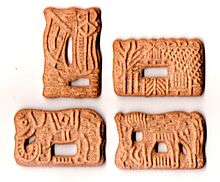- Speculaas
-
Speculaas (Dutch pronunciation: [spekyˈlaːs], French spéculoos) is a type of shortcrust biscuit, traditionally baked for consumption on St Nicholas' Eve in the Netherlands (December 5) and Belgium (December 6).[1] In recent decades it has become available all year round. Speculaas are thin, very crunchy, slightly browned and, most significantly, have some image or figure (often from the traditional stories about St. Nicholas) stamped on the front side before baking; the back is flat.
Speculaas dough does not rise much. Dutch and Belgian versions are baked with light brown (beet) sugar and baking powder. German Spekulatius uses baker's ammonia as leavening agent. Spices used in speculaas are cinnamon, nutmeg, cloves, ginger, cardamom and white pepper. Most Speculaas versions are made from white flour, brown sugar, butter and spices. Some varieties use some almond flour and have slivered almonds embedded in the bottom. Belgian varieties use less or no spice and are sold as speculoos.
For the dough the butter, sugar and spices are mixed. The flour and leavening agent are mixed separately and then added. Bakers take care that the dough doesn't get warm too fast. The dough is stored in a cool place overnight to give the spices time to permeate the dough, and add extra flavor.
There are several interpretations for the origins of the name Speculaas. It may derive from Latin speculum, which means mirror, and refer to the fact that the images are cut as a mirrored bas-relief into a wooden stamp which is then used to decorate the Speculaas. Another explanation of the name refers to the Latin word speculator which, among other meanings, could also refer to a bishop or St Nicholas' epithet "he who sees everything". Specerij the Dutch word for spice is another possible origin.
The Belgian city of Hasselt is known for a local variety of speculaas. On January 13, 1870 Antonie Deplée, a baker from Hasselt, acquired a license for Hasselt speculaas: "une espèce de pain d'amandes connu sous le nom de spéculation" (A kind of almond "bread" known under the name spéculation.) He sold this version locally and abroad.
The German Spekulatius, traditional in Westphalia and the Rhineland, is of the same origin and is very similar. It is popular throughout the country around Christmas. It is mostly eaten in regions close to the Netherlands though, as most Germans eat Weihnachtsstollen for Christmas.
In the United States, New Zealand and Australia, speculaas are often sold as Dutch Windmill cookies.[2]
Modern paste recipe
A few years ago a new version of speculoos was formulated by making it into a paste. It won an award as a new invention. The recipe uses speculaas as the main ingredient, but has a few other ingredients. It has become known as Speculoospasta. The recipe was sold to Lotus Bakeries, that also bought the patent, but was declared void in 2011. Today there are many companies that make different variations of speculoospasta.
See also
- Springerle, a thicker, anise-flavoured, moulded Christmas cookie from Germany
- Ginger biscuits
References
Categories:- Biscuits (British style)
- Almond cookies
- Dutch confectionery
- Dutch words and phrases
- Christmas food
Wikimedia Foundation. 2010.


